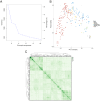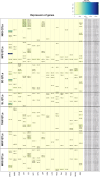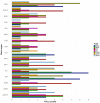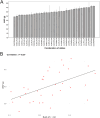Identification of QTLs associated with grain yield-related traits of spring barley
- PMID: 40295941
- PMCID: PMC12038964
- DOI: 10.1186/s12870-025-06588-6
Identification of QTLs associated with grain yield-related traits of spring barley
Abstract
Background: Numerous quantitative trait loci (QTLs) and candidate genes associated with yield-related traits have been identified in barley by genome-wide association study (GWAS) analysis. However, genetic bottlenecks in elite cultivars have reduced diversity, limiting further yield improvements. Grain yield is a complex, polygenic trait shaped by genetic and environmental factors, necessitating integrative breeding approaches. While genomic selection, marker-assisted selection, and GWAS have identified key loci for yield-related traits, functional validation remains a significant challenge.
Results: A total of 346 QTLs for seven barley yield-related traits were identified in GWAS, including 93 stable QTLs across multiple environments. Two major-effect QTLs for spike length and thousand kernel weight, along with several moderate-effect QTLs, show potential for breeding. Candidate gene analysis revealed 134 highly expressed genes linked to stress response, transport, and metabolism. Notable genes include HORVU.MOREX.r3.5HG0514790 (growth and stress adaptation) and HORVU.MOREX.r3.2HG0212810 (seed storage protein). A total of eight presumably novel QTLs were identified. One of the novel QTLs, Hv_TKW_3H.5, had the strongest effect on total barley grain yield. The integration of favorable alleles from eight moderate- and major-effect QTLs significantly influenced the weight of kernels per spike.
Conclusions: This study aimed to identify and characterize QTLs associated with barley yield-related traits through GWAS. Integrating genomic and transcriptomic methods suggests a promising strategy for genomic selection and marker-assisted breeding to enhance barley grain yield.
Keywords: Candidate genes; Expression; GWAS; Gene combinations; SNP; Transcriptome analysis.
© 2025. The Author(s).
Conflict of interest statement
Declarations. Ethics approval and consent to participate: Not applicable. Consent for publication: Not applicable. Competing interests: The authors declare no competing interests.
Figures









Similar articles
-
Marker-trait association for grain weight of spring barley in well-watered and drought environments.Mol Biol Rep. 2019 Jun;46(3):2907-2918. doi: 10.1007/s11033-019-04750-6. Epub 2019 Mar 23. Mol Biol Rep. 2019. PMID: 30904979
-
Genomic dissection of plant development and its impact on thousand grain weight in barley through nested association mapping.J Exp Bot. 2016 Apr;67(8):2507-18. doi: 10.1093/jxb/erw070. Epub 2016 Mar 1. J Exp Bot. 2016. PMID: 26936829 Free PMC article.
-
Genome wide screening and comparative genome analysis for Meta-QTLs, ortho-MQTLs and candidate genes controlling yield and yield-related traits in rice.BMC Genomics. 2020 Apr 10;21(1):294. doi: 10.1186/s12864-020-6702-1. BMC Genomics. 2020. PMID: 32272882 Free PMC article.
-
Genetic Localization and Homologous Genes Mining for Barley Grain Size.Int J Mol Sci. 2023 Mar 3;24(5):4932. doi: 10.3390/ijms24054932. Int J Mol Sci. 2023. PMID: 36902360 Free PMC article. Review.
-
Genetic Architecture of Grain Yield-Related Traits in Sorghum and Maize.Int J Mol Sci. 2022 Feb 22;23(5):2405. doi: 10.3390/ijms23052405. Int J Mol Sci. 2022. PMID: 35269548 Free PMC article. Review.
Cited by
-
Evolution of agricultural biotechnology is the paradigm shift in crop resilience and development: a review.Front Plant Sci. 2025 Jun 19;16:1585826. doi: 10.3389/fpls.2025.1585826. eCollection 2025. Front Plant Sci. 2025. PMID: 40612601 Free PMC article. Review.
References
-
- FAO. The Food and Agriculture Organization of the United Nations. https://www.fao.org/home/en/ (2023). Accessed 20 Jan 2025.
-
- Tanksley SD, McCouch SR. Seed banks and molecular maps: unlocking genetic potential from the wild. Science. 1997;277(5329):1063–6. - PubMed
-
- Haudry A, Cenci A, Ravel C, et al. Grinding up wheat: a massive loss of nucleotide diversity since domestication. Mol Biol Evol. 2007;24(7):1506–17. - PubMed
MeSH terms
LinkOut - more resources
Full Text Sources

